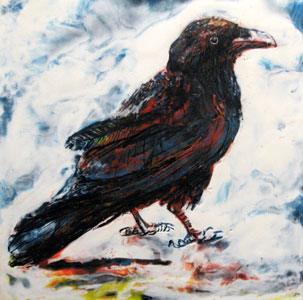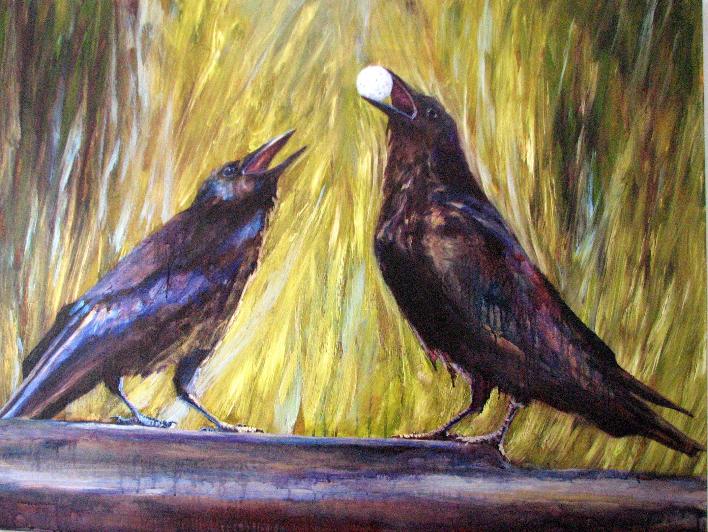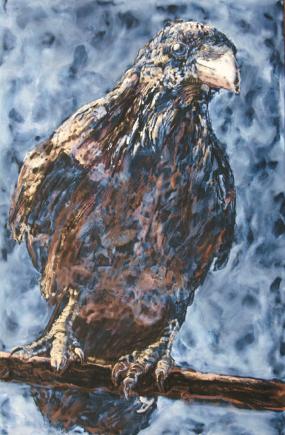Ann, I see your crows and raise you ravens.
With a beak like a Swiss army knife and an intellect to match, the raven is an icon, mascot and pest, as mysterious as it is ubiquitous. For me, as for most people up North, these winged scavengers hover just below my conscious radar. They steal balls from our grass-free golf course, mistaking them for eggs.
The common raven is one of the most prevalent birds in the world, found on every continent except South America and Australia, with four million in North America alone. Corvus corax, from the Greek for “croaker,” has been a North American resident for two million years. When humans came over the Bering land bridge, ravens were already waiting for them. Archeologists have found fossilized ravens in the earliest known human encampments in Canada, dating back 10,000 years.
They have a good deal in common with us. We’re both gregarious and family oriented. We both rely on acute sight and vocal nuance, and we recognize individuals of our species, leaning on memory and mental maps for our survival. Far from picky eaters, we both feed from many links of the food chain – hence the term “ravenous.” And perhaps our spookiest shared behaviour is our walk: like us, the raven perambulates with a lordly strut that conveys pride, purpose and curiosity.
 The raven is often mistaken for its similar-looking cousin, the crow – also black, noisy and everywhere. The most obvious difference is the raven’s imposing size. It can weigh in at over a kilogram. An adult male can grow as big as a hawk, with a wing span of up to a metre. The raven’s flight employs more soaring, less flapping. Compared with the crow’s anemic and repetitive caw, the raven’s low krawk – and its arsenal of other sounds – are a dead giveaway. They’ll imitate bells and woodblocks and dripping water. They’ll croak, trill and cackle. Sometimes their warbling can sound downright conversational.
The raven is often mistaken for its similar-looking cousin, the crow – also black, noisy and everywhere. The most obvious difference is the raven’s imposing size. It can weigh in at over a kilogram. An adult male can grow as big as a hawk, with a wing span of up to a metre. The raven’s flight employs more soaring, less flapping. Compared with the crow’s anemic and repetitive caw, the raven’s low krawk – and its arsenal of other sounds – are a dead giveaway. They’ll imitate bells and woodblocks and dripping water. They’ll croak, trill and cackle. Sometimes their warbling can sound downright conversational.
According to Norwegian lore, mariners used ravens to set a course for land, and Vikings located Iceland with the help of the three ravens they kept on board the ship, letting them fly and following them when they sensed they were close to shore. The biblical character of Noah was not so lucky: His raven never returned from the ark once released, and he had to resort to the more obedient dove, which brought an olive branch back from dry land.
Folklore often picks up on other aspects of the raven’s character as well. A raven’s foot hung around an Inuit newborn’s neck brought the child an ability to endure long periods without food. Assistants to the Norse god Odin, the ravens Hugin and Munin (thought and memory) would venture out each day and return to Valhalla in the evening to report on the world’s goings-on.
Though associated with peskiness and thievery, ravens have also been known to be helpful, especially to hunters. When the birds circle in the distance it’s a safe bet caribou are nearby. Bears look for the same clues to a food source, so the Yukon’s Tr’ondek people mimicked ravens’ calls to attract prey for their bear hunts. This technique, however, wouldn’t work for moose, which are spooked by raven calls because they so often herald the presence of wolves. Nature’s janitors, ravens clear wolf-kills, picking carcasses clean. Our domestic dogs, descendants of wolves themselves, were attractive to ravens for the same reason. And it didn’t take long for ravens to discover that humans are the most wasteful hunters of all. Since the beginning of our co-existence, ravens have thrived on our excesses.
Nowadays, the raven’s insistence on shacking up with us causes urban problems. “We tend to get raven-related power outages in the fall,” says Bob Bromley, a Yellowknife ornithologist. “The young are not stable fliers or perchers, so they flap around and rock on the power lines until they make contact with another line.” During a bird count, Bromley’s team once counted 11 raven carcasses under city power lines. In Yellowknife, the city dump – a raven haven – is located uncomfortably close to the airport, so ravens en route to the mother of all scavenger-heaps become a hazard for pilots.
Images care of Yukon artist Nicole Bauberger, from her collection Fourty Ravens.


Damn, Jessa, I’m not sure that ravens don’t win this one. Not to mention the myth of the trickster, Raven — it now occurs to me that I’ve had a Haida picture of Raven hanging on my wall for the last 20 years and it still spooks me. Ravens have The Power. Crows just talk a lot.
Yes! Raven the Trickster. As the artist who created those encaustics (Nicole Bauberger) says: “If I’m stealing something from a raven by using its image, it’s nothing a raven wouldn’t be perfectly willing to steal from me.” And of their uncanny intelligence, she says: “When I look at a raven, the raven looks back. I feel like we’re gazing at each other as equals. I can’t fly, but the bird can’t drive standard.”
Nevermore.
Oh, for a facebook-esque LIKE function on our comment thread.
There’s a raven in Grand Junction (Colorado) that’s become quite famous in these parts.
From the Grand Junction Daily Sentinel:
The story of the mischievous, infamous raven living on the Redlands is “only this and nothing more,” as Edgar Allen Poe might say.
Known as “Black Bart” in the neighborhoods near The Ridges and Broadway, this raven has a reputation for being a real practical joker.
He’s been known to perch on rooftops to watch residents working on their cars or homes, then swoop down to steal screwdrivers or bolts, only to stash them in one of hundreds of caches.
If he’s in the right mood, he might say, “Hello,” or give a nice long wolf whistle to an unsuspecting pedestrian.
Read the rest here:
http://www.gjsentinel.com/news/articles/pet_or_raven_lunatic_prankster
We have ravens here in Australia. I don’t know if they are the common raven you mention at the beginning. As elsewhere, they’re generally referred to as crows.
I look for ravens but never see them. I am always happy to see crows, though…
Hello Nicole,
A few years ago I bought an encaustic art piece from you while I was living in Yellowknife (a piece called Dip and Soar). It has been in storage for 2yrs, in a rubbermaid in a heated house and I just pulled it out and it is full of hairline cracks and the pieces are wanting to fall out! What should I do to help preserve it? This is my favorite art piece and would like to still enjoy it for many, many years.
Thanks,
Brent